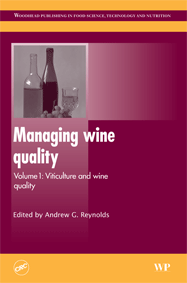Managing Wine Quality, volume 1, edited by Andrew G. Reynolds
| Title of book: | Managing Wine Quality: Volume 1 – viticulture and wine quality |
| Author: | Ed. Andrew G. Reynolds |
| Publisher: | Woodhead Publishing |
| Publication date: | April 2010 |
| ISBN | 978 1 84569 484 5 |
| Pages: | 606 |
| Price: | £160.00 |
 This is self-evidently serious kit for the professional with individual chapters commissioned from senior academicians and researchers at universities and research institutes around the world.
This is self-evidently serious kit for the professional with individual chapters commissioned from senior academicians and researchers at universities and research institutes around the world.
Split into 3 parts, volume 1, by way of a neatly compiled collection of scientific papers, explains grape and wine sensory attributes, and measuring grape and wine properties, before exploring selected viticultural issues such as terroir and precision viticulture and how these issues can affect wine quality. The papers bring together the latest thinking on aspects of wine quality.
The very first chapter succinctly summarises the various types of aroma molecule and suggests there are just over two dozen different odours that, in combination, explain most wine aroma nuances.
Consumers regularly (and erroneously) equate deep colour with high quality, and the paper from the AWRI focuses on why colour is so important, including aspects of astringency in red wine. The complexities of managing colour creation in the vineyard are outlined.
In an era of increasing fraudulent practices, both at the luxury end as well as high volume brands, a chapter is devoted to authenticity and traceability, reviewing traditional and modern techniques used, such as HPLC (high-performance liquid chromatography) as well as FT-IR (Fourrier transorm infrared) and NMR (nuclear magnetic resonance), to ensure a wine is what it says it is. The latter two, we are told, are ‘more recently applied methods for determination of geographical origin and variety, respectively.’
In terms of geographic origin, terroir remains an emotive word in the wine world, often defying colloquial translation, yet science determines to explain it. It seems fitting that this chapter emanates from terroir-central, Bordeaux. It states that terroir expression is enhanced ‘when grapes reach maturity at the end of the growing season and thus ripen in cool conditions’ so grape variety choice needs to be closely matched to the climate. But we are told any direct influence of geology remains elusive though experiments with soil have investigated relationships with grape composition.
There’s inevitably lots of chemistry in some of the chapters of this book, but even so, it’s not beyond the realms of the ordinary mortal. Ultra-detailed stuff can be skimmed without losing the thread of an individual paper.
This book, and its partner volume 2 (read review here) are likely to become part of the pantheon of the professional reference tool kit. They’re probably quite interesting for MW students too.



